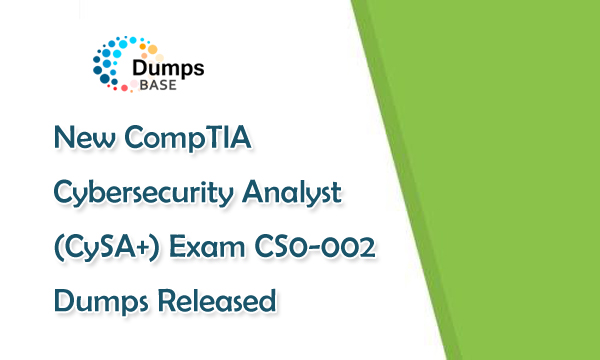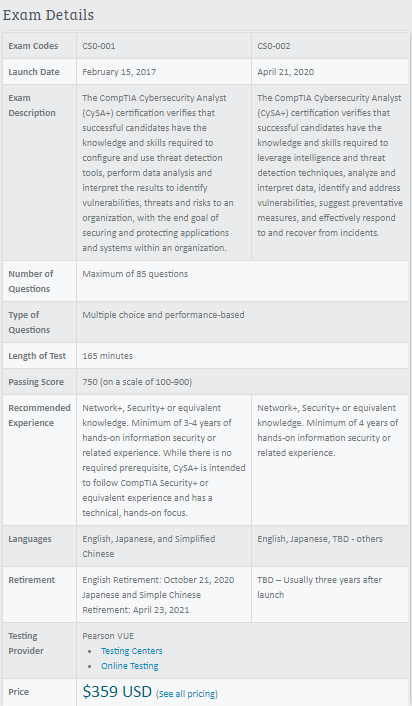New CompTIA Cybersecurity Analyst (CySA+) Exam CS0-002 Dumps Released
CS0-002 CompTIA certification exam was launched on April 21, 2020, which is the new exam for CompTIA Cybersecurity Analyst (CySA+) Certification. You can prepare for your CS0-002 CompTIA Cybersecurity Analyst (CySA+) Certification exam with the new CompTIA Cybersecurity Analyst (CySA+) Exam CS0-002 Dumps. We released CompTIA CySA+ CS0-002 exam dumps on July 7, 2020. CompTIA CySA+ exam dumps from DumpsBase should be the latest version, which is good for testing your skills and knowledge of applying behavioral analytics to networks and devices to prevent, detect and combat cybersecurity threats through continuous security monitoring. We ensure that you can pass CS0-002 CompTIA Cybersecurity Analyst (CySA+) Certification Exam in the first try.

Which is the correct exam for CompTIA Cybersecurity Analyst (CySA+) certification, CS0-001 or CS0-002?
CompTIA Cybersecurity Analyst (CySA+) certification is a hot CompTIA certification, which focuses on your ability to not only proactively capture, monitor, and respond to network traffic findings, but also emphasizes software and application security, automation, threat hunting, and IT regulatory compliance, which affects the daily work of security analysts. CompTIA CySA+ certification will verify the successful candidate has the knowledge and skills required to:
● Leverage intelligence and threat detection techniques
● Analyze and interpret data
● Identify and address vulnerabilities
● Suggest preventative measures
● Effectively respond to and recover from incidents
To complete CompTIA Cybersecurity Analyst (CySA+) certification requires candidates to pass one exam. Most candidates may be familiar with CS0-001 exam. If we state that CS0-002 exam is a new one for CompTIA Cybersecurity Analyst (CySA+) certification, which is the correct exam for this certification. Actually, currently you can choose to pass CS0-001 or CS0-002 exam to complete your CompTIA Cybersecurity Analyst (CySA+) certification. CS0-001 exam verifies that successful candidates have the knowledge and skills required to configure and use threat detection tools, perform data analysis and interpret the results to identify vulnerabilities, threats and risks to an organization, with the end goal of securing and protecting applications and systems within an organization. By comparison, CS0-002 exam verifies that successful candidates have the knowledge and skills required to leverage intelligence and threat detection techniques, analyze and interpret data, identify and address vulnerabilities, suggest preventative measures, and effectively respond to and recover from incidents.
However, CS0-001 exam in English will be retired on October 21, 2020, if you are preparing for CS0-001 exam to take and pass, please make sure you can schedule the CS0-001 exam before that day.

New CompTIA Cybersecurity Analyst (CySA+) Certification Exam, CS0-002 exam has been updated to address industry changes, as well as the need for security analysts to focus on software security and be more proactive with their defense and threat intelligence.
What skills will you learn from CompTIA Cybersecurity Analyst (CySA+) Certification?
CompTIA Cybersecurity Analyst (CySA+) is an IT workforce certification, which applies behavioral analytics to networks to improve the overall state of security through identifying and combating malware and advanced persistent threats (APTs), resulting in an enhanced threat visibility across a broad attack surface. Obviously, CompTIA CySA+ covers the most up-to-date core security analyst skills and upcoming job skills used by threat intelligence analysts, application security analysts, compliance analysts, incident responders/handlers, and threat hunters, bringing new techniques for combating threats inside and outside of the Security Operations Center (SOC). So what skills will you learn? Five main exam topics and measured skills are listed, which you can learn from CompTIA Cybersecurity Analyst (CySA+) Certification:
● Threat and Vulnerability Management
● Software and Systems Security
● Compliance and Assessment
● Security Operations and Monitoring
● Incident Response
As a great certification, CompTIA Cybersecurity Analyst (CySA+) helps you master the skills and prove that you have abilities to:
● Utilize and apply proactive threat intelligence to support organizational security and perform vulnerability management activities
● Apply security solutions for infrastructure management and explain software & hardware assurance best practices
● Apply security concepts in support of organizational risk mitigation and understand the importance of frameworks, policies, procedures, and controls
● Analyze data as part of continuous security monitoring activities and implement configuration changes to existing controls to improve security
● Apply the appropriate incident response procedure, analyze potential indicators of compromise, and utilize basic digital forensics techniques
How to make sure that New CompTIA Cybersecurity Analyst (CySA+) Exam CS0-002 Dumps are great for preparation?
We highly recommend New CompTIA Cybersecurity Analyst (CySA+) Exam CS0-002 Dumps from DumpsBase because we collected all CS0-002 exam dumps questions and answers based on the skills above. All the CompTIA CS0-002 dumps questions are the great preparation materials for CompTIA Cybersecurity Analyst (CySA+) Certification Exam. How to make sure that New CompTIA Cybersecurity Analyst (CySA+) Exam CS0-002 Dumps are great for preparation? We have CS0-002 free dumps online for your reading before getting the full version of DumpsBase CS0-002 dumps.
Read CS0-002 CompTIA CySA+ Free Dumps First
An analyst is performing penetration testing and vulnerability assessment activities against a new vehicle automation platform.
Which of the following is MOST likely an attack vector that is being utilized as part of the testing and assessment?
A. FaaS
B. RTOS
C. SoC
D. GPS
E. CAN bus
Answer: B
IoT devices also often run real-time operating systems (RTOS). These are either special purpose operating systems or variants of standard operating systems designed to process data rapidly as it arrives from sensors or other IoT components.
An information security analyst observes anomalous behavior on the SCADA devices in a power plant. This behavior results in the industrial generators overheating and destabilizing the power supply.
Which of the following would BEST identify potential indicators of compromise?
A. Use Burp Suite to capture packets to the SCADA device's IP.
B. Use tcpdump to capture packets from the SCADA device IP.
C. Use Wireshark to capture packets between SCADA devices and the management system.
D. Use Nmap to capture packets from the management system to the SCADA devices.
Answer: C
Which of the following would MOST likely be included in the incident response procedure after a security breach of customer PII?
A. Human resources
B. Public relations
C. Marketing
D. Internal network operations center
Answer: B
An analyst is working with a network engineer to resolve a vulnerability that was found in a piece of legacy hardware, which is critical to the operation of the organization's production line. The legacy hardware does not have third-party support, and the OEM manufacturer of the controller is no longer in operation. The analyst documents the activities and verifies these actions prevent remote exploitation of the vulnerability.
Which of the following would be the MOST appropriate to remediate the controller?
A. Segment the network to constrain access to administrative interfaces.
B. Replace the equipment that has third-party support.
C. Remove the legacy hardware from the network.
D. Install an IDS on the network between the switch and the legacy equipment.
Answer: D
A small electronics company decides to use a contractor to assist with the development of a new FPGA-based device. Several of the development phases will occur off-site at the contractor's labs.
Which of the following is the main concern a security analyst should have with this arrangement?
A. Making multiple trips between development sites increases the chance of physical damage to the FPGAs.
B. Moving the FPGAs between development sites will lessen the time that is available for security testing.
C. Development phases occurring at multiple sites may produce change management issues.
D. FPGA applications are easily cloned, increasing the possibility of intellectual property theft.
Answer: D
A cybersecurity analyst is contributing to a team hunt on an organization's endpoints.
Which of the following should the analyst do FIRST?
A. Write detection logic.
B. Establish a hypothesis.
C. Profile the threat actors and activities.
D. Perform a process analysis.
Answer: B
A security analyst received a SIEM alert regarding high levels of memory consumption for a critical system. After several attempts to remediate the issue, the system went down. A root cause analysis revealed a bad actor forced the application to not reclaim memory. This caused the system to be depleted of resources.
Which of the following BEST describes this attack?
A. Injection attack
B. Memory corruption
C. Denial of service
D. Array attack
Answer: B
Which of the following software security best practices would prevent an attacker from being able to run arbitrary SQL commands within a web application? (Choose two.)
A. Parameterized queries
B. Session management
C. Input validation
D. Output encoding
E. Data protection
F. Authentication
Answer: AC
A cyber-incident response analyst is investigating a suspected cryptocurrency miner on a company's server.
Which of the following is the FIRST step the analyst should take?
A. Create a full disk image of the server's hard drive to look for the file containing the malware.
B. Run a manual antivirus scan on the machine to look for known malicious software.
C. Take a memory snapshot of the machine to capture volatile information stored in memory.
D. Start packet capturing to look for traffic that could be indicative of command and control from the miner.
Answer: D
A compliance officer of a large organization has reviewed the firm's vendor management program but has discovered there are no controls defined to evaluate third-party risk or hardware source authenticity. The compliance officer wants to gain some level of assurance on a recurring basis regarding the implementation of controls by third parties.
Which of the following would BEST satisfy the objectives defined by the compliance officer? (Choose two.)
A. Executing vendor compliance assessments against the organization's security controls
B. Executing NDAs prior to sharing critical data with third parties
C. Soliciting third-party audit reports on an annual basis
D. Maintaining and reviewing the organizational risk assessment on a quarterly basis
E. Completing a business impact assessment for all critical service providers
F. Utilizing DLP capabilities at both the endpoint and perimeter levels
Answer: AE
